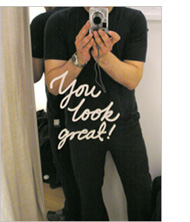Last September, I was in Sweden to give a presentation at Design and Emotion 2006. While shopping in a local department store, I came across a pair of pants that I liked…Once in the fitting room, I put the pants on, my back towards the mirror. Turning around to examine how they fit, I was surprised (and somewhat pleased, I must admit) to see this message on the mirror.

The point of all this? Even though I was very aware that the message was designed to influence my purchase decision, I still experienced an initial, positive, emotional reaction. I can attribute part of that reaction to sheer novelty (since I’ve never seen anything like this in my travels through Canada, the U.S. or Europe). However, I’d have to attribute the remaining portion of my reaction to a compliment; a compliment offered, oddly enough, by an inanimate object.
Had I been less aware of the intent of this message (and I say “less aware” because it’s pretty obvious), the compliment might have been enough to make me purchase an overpriced pair of pants. Flattery has been recognized as an effective persuasion method for a long time, even when it comes from an inanimate object. Logical? No… Emotional? You bet.
For more on how emotions affect purchase decisions see:
Purchase Decisions are Based on Emotional Meaning and
Pain, Pleasure and Purchase Decisions